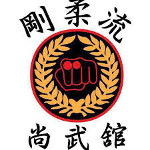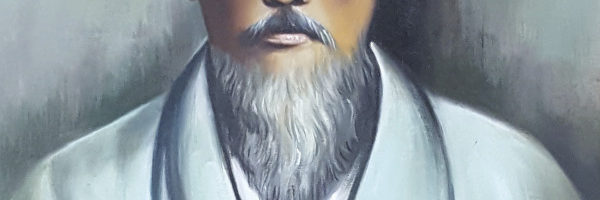Higaonna, Kanryo
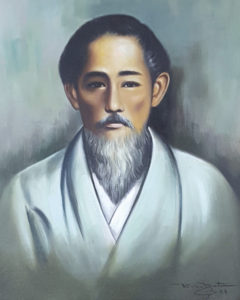
Grandmaster Higaonna was born in Nishimura, Naha to a merchant family whose business was selling goods to the north of Okinawa and shipping firewood back to Naha. Firewood was an expensive commodity in the Ryukyu Islands. His family belonged to the lower Shizoku class known as the Chikudun Peichin.
In 1867, Higaonna began to study Monk Fist Boxing (Luohan Quan) from Aragaki Tsuji Pechin Seisho who was a fluent Chinese speaker and interpreter for the Ryūkyūan court. At that time the word karate was not in common use, and the martial arts were often referred to simply as Te (“hand”). The name of the style was defined by either the family which developed it or the city/region in which it was developed.
In September 1870, with the help of Yoshimura Udun Chomei (an Aji or prince), Higaonna gained the travel permit necessary to travel to Fuzhou on the pretext of going to Beijing as a translator for Okinawan officials. There are records which show that in March 1873 he sailed to Fuzhou in the Fukien province of China.
Aragaki had given Higaonna an introduction to the martial arts master Kojo Taitei whose dojo was in Fuzhou. Higaonna spent his time studying with various teachers of the Chinese martial arts, the first four years he probably studied with Wai Xinxian, Kojo Tatai and or Iwah at the Kojo Dojo. Kanryo then trained under a man referred to as Ryū Ryū Ko, but his name was never recorded as Kanryo Higaonna was illiterate. According to an oral account, Kanryo spent years doing household chores for master Ryū Ryū Ko, until he saved his daughter from drowning during a heavy flood and begged the master to teach Kung Fu as a reward.
In the 1880s, after Ryūkyū was annexed by Japan, Kanryo returned to Okinawa and continued the family business. He also began to teach the martial arts in and around Naha. He began by teaching the sons of Yoshimura Udun Chomei. His style was distinguished by its integration of both go-no (hard) and ju-no (soft) techniques in one system. He became so prominent that the name “Naha-te” became identified with Higaonna Kanryo’s system. He travelled to China several times thereafter. His last visit was in 1898 when he escorted Yoshimura Chomei and two of his sons to Fuzhou. History records that they were blown off-course to Zhejiang and travelled by land to Fuzhou with an escort provided by the local Zhejiang authorities.
Kanryo was noted for his powerful Sanchin kata, or form. Students reported that the wooden floor would be hot from the gripping of his feet.
Miyagi, Chojun
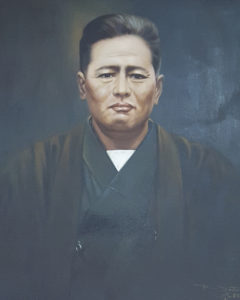
Miyagi, Chojun, the Founder and Grandmaster of Okinawa Goju-Ryu, was born on April 25, 1888. He began his Naha-te (karate) training in1902 under Higaonna, Kanryo. Master Higaonna quickly realized the natural talent, ability and fierce work ethic of Miyagi as he progressed rapidly in the art. It is said, that the training was brutal, pushing Miyagi to his limits on a consistent basis. This intensity made him practice even harder with an enthusiasm unmatched by any of the other students. Chojun Miyagi became “uchi deshi” (private disciple) of Master Higaonna. He studied with his teacher for 14 years before his Master Higaonna’s death in 1915
It was then that Chojun Miyagi knew he must continue to push himself to the limits of endurance in his desire to emulate the extraordinary skills of his teacher. He then decided in 1915 to travel to Fuzhou, China; the city where his teacher had studied the martial arts to further his research. This was one of three trips he made to China during his lifetime. He then combined the knowledge he had gained from his trips to China with his teachings from Master Higaonna, to form his new system, Goju-Ryu. The name of this new system was taken out of a line that appeared in a poem in the Bubishi (a classical Chinese text on the martial arts.) The line was describing the eight precepts of the martial arts, read, “Ho Goju Donto” Which means, “The way of inhaling and exhaling is hardness and softness.”
Chojun Miyagi worked hard to spread karate throughout Okinawa and mainland Japan, and to earn Naha-te a status equal to that of the highly respected Japanese martial arts of judo and kendo. To achieve this he traveled frequently to mainland Japan where he was invited to teach karate at Kyoto University, Kansai University and Ritsumei Kan University. In 1933 karate was registered at the Butokukai, the center for all martial arts in Japan. This was a milestone for karate as it meant that it was recognized on a level with the highly respected martial arts of Japan.
Chojun Miyagi dedicated his whole life to karate. He was responsible for structuring Naha-te (which he later named “Goju-Ryu”) into a systemized discipline which could be taught to society in general. This teaching system which he formulated enabled karate to be taught in schools for the benefit of the young, and to reach vast numbers of people throughout the world. However, his private teaching at his home remained strictly in adherence to the principles and traditions of his teacher, Kanryo Higaonna, and his teacher before him, Ryu Ryu Ko.
Shinjo Masanobu
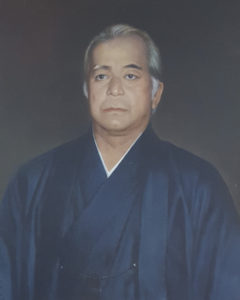
Shinjo began training in 1953, the year Miyagi died. He yearned to capture Miyagi’s unique style as closely to the Master’s way as possible. As the years passed, he made it a point to search out individual student’s of Miyagi to learn their take on his katas and system.
Students and scholars say that Miyagi, like Higaonna before him, didn’t teach all kata to all followers. Hence, one might have become proficient in Sanchin, which everyone learned, and one or two other kata, but not know the rest. Shinjo sought out as many students as he could for a better understanding of the entire system. Because of the fact that Shinjo didn’t study directly from Miyagi or Miyazato, he passed on a style that is slightly different from what might be considered “standard” Goju.
Over the next decades Shinjo would hold anniversary demonstrations and see his organization grow to include schools not only on the mainland of Japan, but also in North and South America, South Africa, Europe, and India. In 1982, Masanobu Shinjo was awarded the 9th dan and the title “Hanshi” by the Okinawa Goju-Ryu Goju-Kai, making him one of the highest ranking Goju-Ryu karate masters on Okinawa.
Master Yagi, who is a 10th dan in Goju-Ryu, described Shinjo as being closer to Master Miyagi in the way he performed kata and techniques than any other Goju-Ryu practitioner. This similarity may have resulted from Shinjo seeking out anyone on Okinawa who had trained under Miyagi for the purpose of studying their individual kata, since Miyagi usually had his students specialize in only one kata, along with Sanchin. In this way, Shinjo was able to learn all aspects of Goju-Ryu as Miyagi had previously done with the study of Naha-Te under Higashionna.
Shinjos’s primary instructor was Toguchi Sekichi, founder of the Shoreikan. Another one of Shinjo’s primary mentors was Meitoku Yagi, who was Miyagi Sensei’s top student. Through this direct lineage, the teachings and integrity of Miyagi’s art were maintained. In 1990, Shinjo succeeded Yagi as President of the Okinawan Goju-Ryu Goju-Kai, while still serving as chief instructor of the organization which he founded, the Okinawan Goju-Ryu Shobukan Association. Shinjo also became the President of the All Okinawa Karate-Do Association, the prestigious organization which encompasses all of the traditional styles of karate-do on Okinawa.
The karate world suffered a serious setback in October of 1993 with the untimely passing of Master Shinjo after a yearlong illness. Like Master Miyagi, Shinjo had spent his life promoting Goju-Ryu, making trips to China and the Shaolin Temple, Taiwan, and visiting his United States Shobukan headquarters and branch schools.
From 1993 through 1998 was a period of restructuring of the Shobukan SoHonbu organization. Seiki Takushi was appointed as SoHonbu Kancho. With the overseeing of the Shobukan by Takushi and other USA Kanchos, the Shobukan adheres firmly and strictly to the high standards of both technique and conduct as established under Shinjo Sensei’s guidance.
The Goju-Ryu Shobukan association is now run by master Shinjo’s oldest son, Kancho Shinjo Masashi. Seiki Takushi still remains a top advisor for the association along with Master Shinjo’s youngest son, Shinjo Takashi, who is the Vice President.
The Shobukan organization remains firm in its dedication to the popularization and internationalization of traditional Okinawan Goju-Ryu Karate-Do. The USA representatives hold yearly training seminars and regularly bring the Shobukan masters to the United States. Any inquiries concerning the Shobukan Organization should be directed to the International Shobukan Organization (Headquarters Okinawa, Japan) or any other USA Kancho that can be found on our Certified Instructors page.
